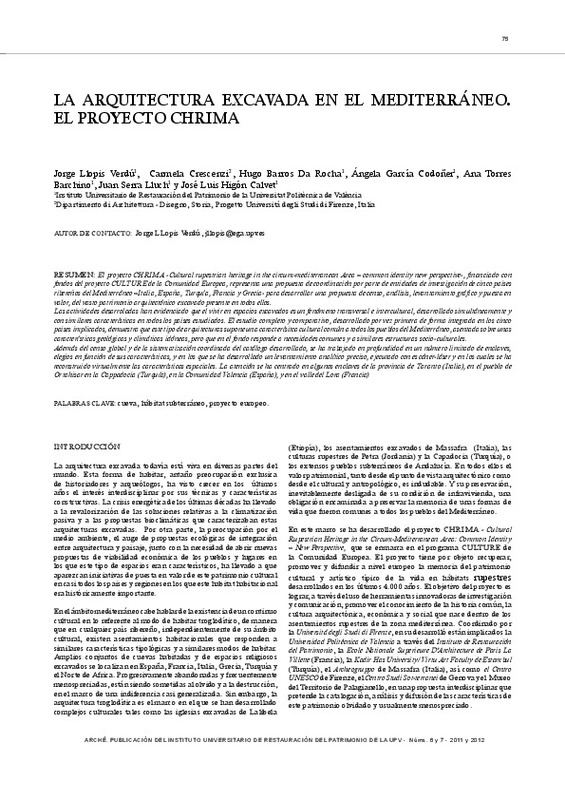JavaScript is disabled for your browser. Some features of this site may not work without it.
Buscar en RiuNet
Listar
Mi cuenta
Estadísticas
Ayuda RiuNet
Admin. UPV
La arquitectura excavada en el mediterráneo. El proyecto CHRIMA
Mostrar el registro sencillo del ítem
Ficheros en el ítem
| dc.contributor.author | Llopis Verdú, Jorge
|
es_ES |
| dc.contributor.author | Crescenzi, Carmela
|
es_ES |
| dc.contributor.author | Barros Da Rocha e Costa, Hugo A.
|
es_ES |
| dc.contributor.author | García Codoñer, Ángela
|
es_ES |
| dc.contributor.author | Torres Barchino, Ana María
|
es_ES |
| dc.contributor.author | Serra Lluch, Juan de Ribera
|
es_ES |
| dc.contributor.author | Higón Calvet, José Luís
|
es_ES |
| dc.date.accessioned | 2013-10-23T12:40:47Z | |
| dc.date.available | 2013-10-23T12:40:47Z | |
| dc.date.issued | 2011 | |
| dc.identifier.issn | 1887-3960 | |
| dc.identifier.uri | http://hdl.handle.net/10251/33050 | |
| dc.description.abstract | El proyecto CHRIMA -Cultural rupestrian heritage in the circum-mediterranean Area ¿ common identity new perspective-, financiado con fondos del proyecto CULTURE de la Comunidad Europea, representa una propuesta de coordinación por parte de entidades de investigación de cinco países ribereños del Mediterráneo ¿Italia, España, Turquía, Francia y Grecia- para desarrollar una propuesta de censo, análisis, levantamiento gráfico y puesta en valor, del vasto patrimonio arquitectónico excavado presente en todos ellos. Las actividades desarrolladas han evidenciado que el vivir en espacios excavados es un fenómeno transversal e intercultural, desarrollado simultáneamente y con similares características en todos los países estudiados. El estudio completo y comparativo, desarrollado por vez primera de forma integrada en los cinco países implicados, demuestra que este tipo de arquitecturas supone una característica cultural común a todos los pueblos del Mediterráneo, asentada sobre unas características geológicas y climáticas idóneas, pero que en el fondo responde a necesidades comunes y a similares estructuras socio-culturales. Además del censo global y de la sistematización coordinada del catálogo desarrollado, se ha trabajado en profundidad en un número limitado de enclaves, elegios en función de sus características, y en los que se ha desarrollado un levantamiento analítico preciso, ejecutado con escáner-láser y en los cuales se ha reconstruido virtualmente las características espaciales. La atención se ha centrado en algunos enclaves de la provincia de Taranto (Italia), en el pueblo de Ortahisar en la Cappadocia (Turquía), en la Comunidad Valencia (España), y en el valle del Lora (Francia) | es_ES |
| dc.description.abstract | The CHRIMA project - Cultural rupestrian heritage in the circum-Mediterranean Area ¿ common identity new perspective- is funded by the European Community CULTURE project and proposes coordination by research institutions from five countries bordering the Mediterranean, Italy, Spain, Turkey, France and Greece, to develop a proposal for a census, graphic analysis, survey and assessment of the vast excavated architectural heritage present in all of them. The common activities undertaken have born witness that living in carved out spaces is an intercultural and transversal phenomenon, simultaneously developed and with similar features in all the countries under study. Thexhaustive and comparative analyses, which were developed in an integrated way in the five countries for the first time, shows that such architecture typology features common cultural characteristics among all Mediterranean peoples that settled in ideal geological and climatic characteristics, but which in the end correspond to common socio-cultural structures and similar necessities. In addition to the global census and the coordinated systematization of the developed catalog, further detailed work was carried out on a limited number of sites chosen for their characteristics, and where precise analytical survey has been performed with the help of laser-scanner. Later, the spatial characteristics of these chosen sites have been virtually reconstructed. We have focused on some enclaves in the province of Taranto (Italy), in the village eof Ortahisar in Cappadocia (Turkey), in the Community of Valencia (Spain), and in the valley of Loire (France). | es_ES |
| dc.format.extent | 12 | es_ES |
| dc.language | Español | es_ES |
| dc.publisher | Instituto Universitario de Restauración del Patrimonio de la UPV | es_ES |
| dc.relation.ispartof | Arché | es_ES |
| dc.rights | Reserva de todos los derechos | es_ES |
| dc.subject | Cave | es_ES |
| dc.subject | Excavated dwelling | es_ES |
| dc.subject | European project | es_ES |
| dc.subject | Cueva | es_ES |
| dc.subject | Hábitat subterráneo | es_ES |
| dc.subject | Proyecto europeo | es_ES |
| dc.subject.classification | CONSERVACION Y RESTAURACION DE BIENES CULTURALES (UPV) | es_ES |
| dc.title | La arquitectura excavada en el mediterráneo. El proyecto CHRIMA | es_ES |
| dc.title.alternative | Excavated architecture in the mediterranean: the CHRIMA project. | es_ES |
| dc.type | Artículo | es_ES |
| dc.rights.accessRights | Abierto | es_ES |
| dc.contributor.affiliation | Universitat Politècnica de València. Instituto Universitario de Restauración del Patrimonio - Institut Universitari de Restauració del Patrimoni | es_ES |
| dc.description.bibliographicCitation | Llopis Verdú, J.; Crescenzi, C.; Barros Da Rocha E Costa, HA.; García Codoñer, Á.; Torres Barchino, AM.; Serra Lluch, JDR.; Higón Calvet, JL. (2011). La arquitectura excavada en el mediterráneo. El proyecto CHRIMA. Arché. (6):75-86. http://hdl.handle.net/10251/33050 | es_ES |
| dc.description.upvformatpinicio | 75 | es_ES |
| dc.description.upvformatpfin | 86 | es_ES |
| dc.description.issue | 6 | es_ES |
| dc.identifier.eissn | 2445-1150 |






